
The institution of bridewealth exists throughout Africa, having counterparts in the custom of the European dowry and, to a lesser extent, in prenuptial agreements. The institution does not refer to purchasing a wife, but to compensating the bride's family for the loss of its daughter's services, which will now benefit her new family. The typical scenario requires the groom, or the family of the groom, to provide gifts, or bride price, to the family of the bride. Many objects were acceptable as bridewealth, but among the most striking were the enormous iron blades of the Turumbu peoples. These spear blades span up to five feet long and typically weigh as much as four and a half pounds. The size of the blade determined its relative value. The blades served as a measure of wealth and were usually not converted into more utilitarian objects. If the marriage failed, the groom's family would attempt to reclaim the bridewealth.
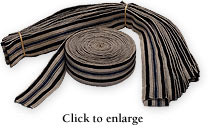
Another widely used common currency was woven goods. Two types are a part of this exhibition,the cotton woven strip roll and the raffia mat or bundles. Strip cloth known among Nigerians as gabanga was often plain and un dyed. As a rule, the strips had a standard width between four and six inches. Variations in width and the quality of the weave gave the parties of the transaction a means to negotiate value. Cloth was also frequently used in connection with other currencies, such as brass rods, lending additional flexibility to the negotiations. As there was no government regulation of cloth production, its circulation was limited by the cost and effort of production (the need to spin fibers into threads and then weave the fabric) and by demand. Cloths or mats of more-or-less uniform size were used for gifts, peace offerings, payment from a son to his father upon attaining adulthood and payment upon the birth of a child or the burial of a parent. Cloth currency was also used as a tribute for a spouse who remained chaste or, by contrast, as a penalty for adultery.
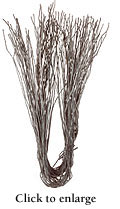
In some areas of central Africa, unadorned copper and iron rods and wires served as currency until about 1907. Instead of being valued according to weight, these currencies were priced by length. In the Congo River region, these rods came to be used to set the price for goods, which could then be purchased for equivalent values in other currencies, whether beads, cloth or other items. Although these rods were to have a fixed length, they often lost length as they passed from hand to hand. In one area, the rods lost more than 20 inches in the span of about 24 years. Bundling tiny copper and brass wires provided an alternative form of exchange for small transactions.
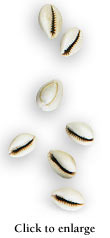

These shells were an ancient money used not just in Africa, but throughout the world, predating the use of coins or in some instances used in the same economy as metal coins. Imported from the Maldive Islands in the Indian Ocean, these polished, olive-sized shells served for small everyday transactions and, gathered together in the millions, for bridewealth (a groom's gift to the family of the bride) and other major purchases and gifts. In the 18th century, one could purchase a cow for 2,500 shells, a goat for 500 shells and a chicken for 25 shells. The shells were counted and measured in many different combinations, but the most typical in some parts of Africa was the rotl, a string consisting of 32 shells, which was then aggregated in strings of 5 to constitute a bunch. Ten bunches was called a head. The shells were believed to possess the power of fertility, thus ensuring their acceptance throughout the wide territories of Africa.
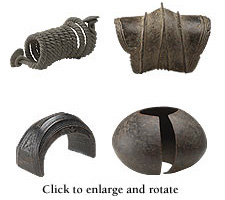
Bracelets, anklets and collars that were cast or hammered from copper had little circulation and were never used in connection with routine transactions. Instead, they served as reservoirs of wealth in a form that was easy to store and transport. This storage function is best illustrated in the very heavy bracelets and anklets of the Congo River region. To create some of these bracelets, such as that of the Ekonda, the artists poured molten metal directly into a cast in the ground called a puddle mold. As the metal cooled, it was wrapped into a circular shape and often even fitted directly to the wearer's body.
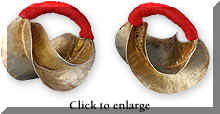
The currencies with the most obvious artistic values are the various bracelets, collars and earrings crafted from gold and silver.
Large gold earrings, called kwottenai, are worn by married Fulani women in Mali. They are handed down from mother to daughter or by purchase when a husband makes a gift to his wife. Kwottenai can become very large, representing the accumulated wealth of several generations. They are formed from gold bars that are beaten into thin blades, which are then formed into crescent shape. Often the blades are incised with figures, flowers or cattle. The mercantile value of these earrings is calculated by the weight of the gold, but the artistry of the goldsmith contributes greatly to the prestige of the owner.
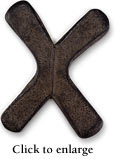
Katanga currency
Few sites in Africa yielded as large a supply of copper ore as the Katanga region of the Democratic Republic of the Congo. While archaeologists believe that even unrefined lumps of copper were used as currency because of their standard size and value, the copper currency that possessed refined casting techniques and artistic value were the ingots shaped as crosses. By 1400 A.D. two distinctive types had developed. One was shaped like an H; the other was formed like an X. The crosses were cast directly on the ground in many sizes. The typical size was about nine and a half inches across, with weights varying up to four pounds. Archaeologists also believe that the larger crosses were made first, followed by the smaller ones as the demands of commerce rose. The crosses were accepted as trade items throughout central Africa. They also served as a source of copper for re-use in jewelry as well as for other currency.

These long, thick iron wires, usually between 12 and 15 inches long, were traded throughout Sierra Leone, Liberia and Guinea. With the exception of Guinea, kissi pennies were still in use in the 1970s. The ends were flattened, with one of the ends shaped like a wing, and the wires were often bundled and twisted together to create higher values. They were called the coins with soul, and if a penny was broken, it could not circulate until repaired by a blacksmith, who would restore its "soul."
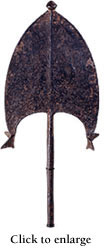
Probably the most dramatic and certainly the most varied metal currency forms are objects believed to be derived from implements and weapons. Popularly known respectively as hoe money and throwing knives, these objects were fabricated from copper, bronze, brass and iron.
Hoe money came in the shape of a heart, spade, paddle, teardrop, trowel, anchor or blade. In fact, the shapes began to overlap with the objects classified as knives or blades. Hoe money varied in value but was most often used as bridewealth. It was also frequently re-formed into other objects or implements as needed.
Currency derived from the throwing knife also came in many shapes and sizes, but its distinctive feature is the complexity in the orientation and size of its blades. These flattened shapes, often very thin, posed technical challenges to the blacksmith that required considerable skill and craftsmanship. In addition, many of the throwing knives were elaborately decorated, some on the blades and others only on the handles. Throwing knives are reported to have been used for bridewealth. Other evidence suggests, however, that they were emblems of office or status, carried in dances or other ceremonial occasions, and not currency at all.
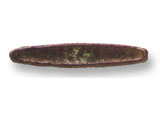
Lat Money was produced in different sizes denoting value denomination. Some, if not all, were marked with either an elephant or a snake symbol. Lat money seemed to have been used as a smaller value currency compared to Tiger Tongue pieces.
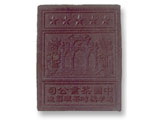
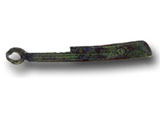
The knife money of the Shantung Peninsula is far less complex than the spade money, but is still poorly understood.
The monetary designation of knife money is "HOU", derived from a character meaning "to change" or "to exchange in trade". It is fairly easy to see how this meaning could become a denomination of money. Later, when the early round coins first appeared, the unit of "HOU" came to be used as a more general denomination.
POINTED KNIVES
We assume the pointed knifes, with a smooth curve down the back, are the earliest form of knife money. They have the closest style to genuine knives, and like the early hollow-handled spades often appear without inscriptions, although the inscriptions are normally weak or difficult to see on most specimens. The casting and calligraphy are similar to the hollow-handled spades. This leads us to believe they first appeared at about the time of the inscribed hollow-handled spades and overlap with the heavy flat spades, probably in the late 5th century BC.
Although most pointed knives look very similar, there are actually a number of distinctive variations in the blade shapes that are almost certainly different issues. At this point we cannot go into the details of this, but a some future date we will try to add more information about them. There is a very good listing of them in the Shanghai Encylopedia.
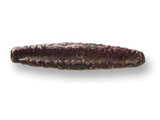
Lan Chang Kingdom
While Sukhothai and Lanna power were the main focus of development in the central and northern part of Thailand, other Thai or related groups had developed small communities in Laos, northeast Thailand and along the Mekhong river.
Hoi Money
Hoi Money , Tiger tongue, money or market money in silver were all prevailing currencies of the period. This money might carry two or more marks stamped on its concave surface, but usually three. The constant marks stamped on the Hoi money were elephants and the Chakra, but sometimes with one more marks of lotus, bunches of flowers or Dok Pikul etc.

Manillas were open bracelets, cast from copper and then brass and later still from iron. From the late 15th to the early 20th centuries, they circulated widely, especially along the West African equatorial coast, in various sizes and weights. Manillas were also cast in Birmingham, England, and traded as currency in West Africa.
The manillas in this exhibition include the smaller standard size and the so-called queen manilla. The larger specimens were considered a store of wealth. Small manillas would often be amassed and then taken to the blacksmith to be melted and re-formed into the larger size.
Some manillas were decorated with incised designs, or a second coil of metal was twisted around the shank. The quality of their ringing sound and the amount of "flash," or excess metal extruded at the joints of the mold, helped determine their value. Metalsmiths from the Kingdom of Benin, part of today's Nigeria, melted down the imported manillas and recast the metal into works of art.